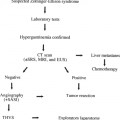
Parathyroid Venous Sampling
Primary hyperparathyroidism is an insidious disease that produces hypercalcemia and can lead to debilitating metabolic disarray. The source of abnormal parathyroid hormone (PTH) production can be parathyroid adenoma, hyperplasia, or (rarely) malignancy. The treatment of choice is surgical removal of the hypersecreting tissue, and the cure rate approaches 95% in the hands of experienced surgeons. Patients who remain hypercalcemic after attempted surgery often exhibit considerable morbidity, however, as a result of continued hyperparathyroidism, largely because the source of abnormal PTH production cannot be identified. Potential unusual locations of parathyroid tissue, inability to differentiate normal from abnormal parathyroid tissue at surgery, and suboptimal accuracy of various localizing imaging techniques (especially in the postoperative patient) compound the problem of accurate diagnosis. Parathyroid venous sampling has emerged as a viable complement to imaging techniques and is used routinely in patients for whom initial surgery fails.
 Localization and Treatment Options
Localization and Treatment Options
A wide array of imaging techniques have been applied to the localization of the hypersecreting parathyroid gland, including computed tomography, ultrasonography, magnetic resonance imaging, nuclear medicine imaging (currently using Tc 99 sestamibi), positron emission tomography (PET), angiography, and retrograde thyroid venography.1–9 The common feature among all these techniques is the identification of a radiographic abnormality to provide accurate diagnosis. In addition, biopsy of suspected abnormal parathyroid tissue has been used as a diagnostic measure.10 Compared with imaging techniques, this means of diagnosis does not require an imaging abnormality.
Treatment usually consists of direct surgical identification and removal of the hypersecreting parathyroid gland.11–15 Thoracoscopic surgery16 also has been used, as has selective transarterial ablation with radiographic contrast.17
 History of Parathyroid Venous Sampling
History of Parathyroid Venous Sampling
The availability of a reliable radioimmunoassay for PTH in 1970 led to the identification of selective venous sampling as an alternative diagnostic method for the detection of hypersecreting parathyroid tissue.4,18–22 This technique used a collection of small amounts of venous blood from multiple, specific, recorded locations in neck and mediastinal veins. Assay of these samples allowed identification of specific veins, which demonstrated exceptionally high PTH levels. The benefit of this venous sampling technique was its independence from the need to specify an imaging abnormality. The abnormally high PTH level was simply cross-referenced to the recorded sample source to provide anatomic localization. This was particularly beneficial in the unusual and confounding situation of multiple adenomas.
 Anatomic Considerations
Anatomic Considerations
Successful parathyroid venous sampling requires placement of a catheter into multiple neck and mediastinal veins. The normal parathyroid glands drain through the thyroidal veins, which demonstrate a variable drainage pattern. The classic pattern consists of paired superior, middle, and inferior thyroidal veins. Seldom is this classic venous anatomy identified, because of variability and previous surgery. Nonstandard parathyroid locations are encountered frequently, especially in patients in whom initial surgery is unsuccessful. Mediastinal, paraesophageal, and undescended (parathymic) gland locations require sampling of internal jugular, innominate, hemiazygos, and azygos veins as well.
 Technique
Technique
Stay updated, free articles. Join our Telegram channel

Full access? Get Clinical Tree



